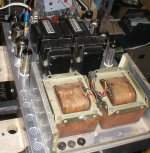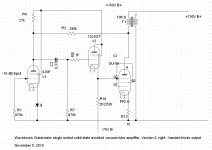Hello ,
Before I start killing 4P1L left right and centre , could some of the Russian speakers help with the maximum ratings from the datasheet ? I see that one of the maximum anode voltage ratings is 250V but is that an absolute max of 300V ? What about G2 ? It seems like a nice valve , well worth experimentation .
many thanks
316A
Before I start killing 4P1L left right and centre , could some of the Russian speakers help with the maximum ratings from the datasheet ? I see that one of the maximum anode voltage ratings is 250V but is that an absolute max of 300V ? What about G2 ? It seems like a nice valve , well worth experimentation .
many thanks
316A
Attachments
The file you uploaded is a bit fuzzy, but I did look it up on Frank's (vade mecum option selected) pages here http://www.mif.pg.gda.pl/homepages/frank/short/054/2/206.pdf and here is what I found:
Filament Voltage: 2.1/4.2 volts @ 650mA/325mA respectively
Recommended plate voltage: 200V with 150V on the screen
Maximum operating voltage 250V plate or screen.
Maximum cathode current: 50mA
Plate dissipation: 7.5W
Screen dissipation: 1.5W
Screen currents of 10mA are typical at 150V and here is the kicker, control grid currents of 1mA are permissible. I suspect this might have been for RF operation, I can't imagine given the relatively high transconductance and the low dissipation ratings that A2 would have been employed. (Guess on my part.)
Transconductance might be in the range of 6mA/V but I am not sure.
Based on the wide allowable voltage range on the filament supply I suspect these tubes were originally intended for operation on lead acid storage batteries.
I can't see any reason why you couldn't triode connect this tube if you wanted to..
Take a careful look at the vade mecum page as several sets of operating conditions seem to be implied several of which are audio related. (Some RF as well.)
One other thing is notice that the recommended voltage on G3 seems to be 15V... For audio applications I suspect this electrode should be tied to the cathode, but it is worth mentioning.
Hope this is somewhat helpful.
Filament Voltage: 2.1/4.2 volts @ 650mA/325mA respectively
Recommended plate voltage: 200V with 150V on the screen
Maximum operating voltage 250V plate or screen.
Maximum cathode current: 50mA
Plate dissipation: 7.5W
Screen dissipation: 1.5W
Screen currents of 10mA are typical at 150V and here is the kicker, control grid currents of 1mA are permissible. I suspect this might have been for RF operation, I can't imagine given the relatively high transconductance and the low dissipation ratings that A2 would have been employed. (Guess on my part.)
Transconductance might be in the range of 6mA/V but I am not sure.
Based on the wide allowable voltage range on the filament supply I suspect these tubes were originally intended for operation on lead acid storage batteries.
I can't see any reason why you couldn't triode connect this tube if you wanted to..
Take a careful look at the vade mecum page as several sets of operating conditions seem to be implied several of which are audio related. (Some RF as well.)
One other thing is notice that the recommended voltage on G3 seems to be 15V... For audio applications I suspect this electrode should be tied to the cathode, but it is worth mentioning.
Hope this is somewhat helpful.
Last edited:
4П1Л tube was used in military transmitters. Kevin is right, it has 6 miliamper per volt transconductance.
It is very popular now among Russian audiophiles.
Long time ago when I was a kid I disassembled for parts so called KRU (КРУ, Колхозный Радио Узел, i.e. Collective farmers' Radio Studio), it was battery powered AM receiver with 4 presets, and 2 x 4P1L output tubes. Output power was 10W (!)
It is very popular now among Russian audiophiles.
Long time ago when I was a kid I disassembled for parts so called KRU (КРУ, Колхозный Радио Узел, i.e. Collective farmers' Radio Studio), it was battery powered AM receiver with 4 presets, and 2 x 4P1L output tubes. Output power was 10W (!)
An externally hosted image should be here but it was not working when we last tested it.
I run them as preamp tubes, microphony is not a problem, though I run them under filament spec’. I run 1.2V across half the filament, (2.4V total). As mentioned they are battery radio tubes so they are forgiving on filament voltage. Lower filament voltage can quiet screeching directly heated tubes in my experience.
Klaus as usual has great info at,
Tube Tester Files - 4P1L
Matt
Klaus as usual has great info at,
Tube Tester Files - 4P1L
Matt
4P1L push pull amp Now built . Ripped apart the first power amp I did in 1998 as a triode strapped Bevios Valley , it's had EL84 , paralleled 5687 , EL822 , PL508 and now 4P1L . The chassis is starting to look like a swiss cheese . Gone with a VT50 DHT input , paralleled 6N6P concertina with the 4P1L triode strapped with G2 and G3 strapped to the anode . Output transformers are from an old Pioneer receiver (8K a-a) . The chassis houses 10 independent heater/filament supplies , six of these CCS fed DC for the filaments . VT50 runs with 11 ohm filament bias resistor via a DN2540 CCS set to 100mA , 4P1L runs from CCS connected LM1084-ADJ . Investigation is needed , it sounds very good but there is bad microphony with one VT50 (which is also prone to hum) and one 4P1L which howls for a good 30 seconds when tapped . I'll try backing off the CCS a tad .
cheers
316A
cheers
316A
Attachments
If an output tube howls when taped you very likely have HF oscillation.
It's microphony , all the other 4P1L are fine , those filaments are slighty 'wet stringy' after all . Layout is fairly tight and close and 200 ohm grid stoppers have been used , the problem remains with the valve in an alternate socket . LM1084 fialment CCS are set to 318mA (30R9 paralled with 4R5) , but the voltage at the terminals is between 4.25-4.38V between all four valves . In my experience oxide filament DH valves tend to sound better and be less microphonic run slightly under ratings , I'll re-do the 4P1L CCS tommorow night at 310mA , maybe 300mA . It's easy with the VT50 , Rset is a multiturn pot and the current can be measured across the 11 ohm filament bias resistor . If the VT50 still hums and howls I have plenty more
cheers
316A
Last edited:
Since I have replied to this thread I got a bunch of these thanks to Wavebourne's suggestion. They are headed for a small, simple 2W SE amp. The triode curves for this thing are spectacularly good, and I will start on the design once I finish the GM70 amps which are coming along well.
What kind of power do you think you could get running them PP?
Depends on distortions you can accept. They were used in one power amp with 10W output in class AB pentode (see my previous link on KRU amp) manufactured in 1960'th, when agriculture was considered by Nikita Khrushchev as equal to military, and that amps were manufactured for Collective Farms.
They are very nice for class A in triode, and give up to 2.5W per tube when driven with up to +12V on control grid. It is easy to parallel them, since they are consistent and very linear: paralleling linear tubes you are loosing power on mismatch, i.e. the tube with higher transconductance will draw more, no distortion raise caused by mismatch. 2A3, for example, has a pair of paralleled triodes inside. You can parallel ten of 4P1L tubes matching them (it's easy), to get 100W dissipation and 25W output.
Since I have replied to this thread I got a bunch of these thanks to Wavebourne's suggestion. They are headed for a small, simple 2W SE amp. The triode curves for this thing are spectacularly good, and I will start on the design once I finish the GM70 amps which are coming along well.
Kevin Hi
I just joined you too !
My 4P1L's will buffer a low - ish gain LM3886 GC - once I've got the traffo bought ( a hybrid plan )
It all started after I managed to fire a signal direct off a dac chip to a pair of 6N6P's - with advice from a canadian valve nut !!
Hooked now - no turning back
Andrew
Hi, I just joined too. I use an amp with 4P1L in triode connection, but I found that the load on the g2 is greater than it should be, and the anode dissipation is still around 5-6 W only. So I conneted 0...+24V through a 470 ohm divider to the g1, -30V and the drive to the g2, and the g3 to the anode. Much better than the simple triode connection;
less internal resistance, better efficiency,..
less internal resistance, better efficiency,..
Hi Wavebourn
Thanks for the reply.After reading about Soviet valves at your site and also dialogue with quikie I decided to give the 4p1l a go.
A search for right handed triode yielded the following gu50 schemes...but no 4p1l.
Thanks for the reply.After reading about Soviet valves at your site and also dialogue with quikie I decided to give the 4p1l a go.
A search for right handed triode yielded the following gu50 schemes...but no 4p1l.
Attachments
- Status
- This old topic is closed. If you want to reopen this topic, contact a moderator using the "Report Post" button.
- Home
- Amplifiers
- Tubes / Valves
- Russian-English Translation of 4P1L datasheet

